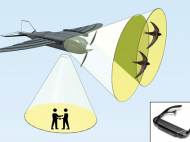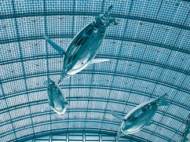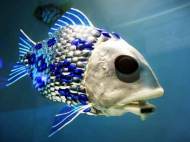Top 5 articles regarding biomimicry of flora and fauna in 2009
 One of the major themes our website covers is bionics. Bionics (also known as biomimetics, bio-inspiration, biognosis, biomimicry, or bionical creativity engineering) is the application of biological methods and systems found in nature to the study and design of engineering systems and modern technology. Some dictionaries, however, explain the word as being formed from biology + electronics.
One of the major themes our website covers is bionics. Bionics (also known as biomimetics, bio-inspiration, biognosis, biomimicry, or bionical creativity engineering) is the application of biological methods and systems found in nature to the study and design of engineering systems and modern technology. Some dictionaries, however, explain the word as being formed from biology + electronics.
Here are the 5 most popular articles according to our visitors:
5. It’s a bird, it’s a plane, it’s RoboSwift
 During its lifetime, single swift flies a distance comparable to five roundtrips to the Moon and can remain in the air continuously for 7000 kilometers. Lentink and his associates discovered that the swift can fly so efficiently and maneuver so well because it continuously adapts the shape of its wings to the flying conditions. These large benefits are possible because the swift can very precisely adjust its feathers to the flight condition. It changes several parameters simultaneously during morphing, including wing sweep, wind area, the local curvature of the wing (airfoil camber) and the wing slenderness (aspect ratio).
During its lifetime, single swift flies a distance comparable to five roundtrips to the Moon and can remain in the air continuously for 7000 kilometers. Lentink and his associates discovered that the swift can fly so efficiently and maneuver so well because it continuously adapts the shape of its wings to the flying conditions. These large benefits are possible because the swift can very precisely adjust its feathers to the flight condition. It changes several parameters simultaneously during morphing, including wing sweep, wind area, the local curvature of the wing (airfoil camber) and the wing slenderness (aspect ratio).
The RoboSwift is characterized by the continuously variable shape of its wings, known as ‘morphing’ wings, which are modeled on the wings of the swift. These wings make the aircraft, like its living model, very maneuverable and efficient. As a result, the RoboSwift is the first aircraft in the world to have the wing properties of living birds. Wind tunnel tests have shown that it can come remarkably close to the exceptional flying ability of the swift.
4. Robot octopus shows great potential as an addition to mini subs
 One of the special abilities octopuses have is that their body has no rigid structure. Thanks to that ability, the octopus can adapt its shape to the environment and its whole body can be squeezed into very small aperture. The octopus has the capability to twist, elongate, and bend its arms in all directions and, despite of the lack of rigid skeletal support, can vary the stiffness of its tentacles in order to apply relatively high forces.
One of the special abilities octopuses have is that their body has no rigid structure. Thanks to that ability, the octopus can adapt its shape to the environment and its whole body can be squeezed into very small aperture. The octopus has the capability to twist, elongate, and bend its arms in all directions and, despite of the lack of rigid skeletal support, can vary the stiffness of its tentacles in order to apply relatively high forces.
Cecilia Laschi, of Scuola Superiore Sant’Anna in Pisa, and her colleagues are attempting to build a robot with arms that work in the same way that octopuses’ tentacles do. Having no solid skeleton, it will be the world’s first entirely soft robot. Their goal is to use the knowledge related to the principles that give rise to the octopus sensory-motor capabilities and incorporate them in new design approaches in robotics. It is mainly based on the anatomy of the 8-arm body of an octopus, with similar performance in water, in terms of dexterity, speed, control, flexibility, and applicability.
3. AirPenguin – flying robot penguins, what’s next?
 Besides being cute, penguins are amazingly good swimmers. In their search for food, penguins often travel more than a hundred kilometers per day; they are able to dive in depths up to 700 meters. They are fast n the water, have a great deal of endurance and are astoundingly agile and can reach a top speed of almost 30 kilometers per hour. Those facts inspired German company Festo to make the AirPenguin.
Besides being cute, penguins are amazingly good swimmers. In their search for food, penguins often travel more than a hundred kilometers per day; they are able to dive in depths up to 700 meters. They are fast n the water, have a great deal of endurance and are astoundingly agile and can reach a top speed of almost 30 kilometers per hour. Those facts inspired German company Festo to make the AirPenguin.
Despite it is 3.7 meters long the AirPenguin is an agile and maneuverable autonomous flying object. It comprises a helium filled balloon, which has a capacity of approximately 1 cubic meter and thus generates around 1kg of buoyant force. At each end of the balloon is a pyramid-shaped flexible structure of four carbon fiber rods, which are connected at joints by a series of rings spaced 10cm apart. The rings together with the carbon fiber rods yield a 3D Fin Ray structure that can be freely moved in any spatial direction.
2. Fish robots search for pollution in the waters
 The 1.5 meter carp-shaped robots are part of a three-year research project of Huosheng Hu and his robotics team at the School of Computer Science and Electronic Engineering, University of Essex. If the research proves itself, the robot fish could be used in rivers, lakes and seas across the world. By controlling the environment for pollutants and providing feedback about the condition of the waters, this project should bring us a step closer to our greener future.
The 1.5 meter carp-shaped robots are part of a three-year research project of Huosheng Hu and his robotics team at the School of Computer Science and Electronic Engineering, University of Essex. If the research proves itself, the robot fish could be used in rivers, lakes and seas across the world. By controlling the environment for pollutants and providing feedback about the condition of the waters, this project should bring us a step closer to our greener future.
The robot fish have autonomous navigation capabilities, enabling them to swim independently around the port without any human interaction. This enables them to return automatically to their hub to be recharged when battery life (approximately eight hours) is low.
1. Biomimicry of heliotropic plants – more efficient solar panels
 Many plants are heliotropic, gradually tilting towards the sun to optimize solar energy capture. From an expressive standpoint, a solar panel that tilts towards the sun (like a sunflower) can help the public see a connection between the natural and the high tech. Solar cells that track the angle of the sun can be 38 percent more efficient at generating power than those that are mounted in a fixed position.
Many plants are heliotropic, gradually tilting towards the sun to optimize solar energy capture. From an expressive standpoint, a solar panel that tilts towards the sun (like a sunflower) can help the public see a connection between the natural and the high tech. Solar cells that track the angle of the sun can be 38 percent more efficient at generating power than those that are mounted in a fixed position.
A team of three MIT students (Forrest Liau, Vyom Sharma, and George Whitfield) designed such a system. They designed the system that imitates the way plants track the sun across the sky, by using the difference in temperature between shaded and sunny areas to change the properties of the material supporting solar photovoltaic cells. Unlike the systems which are currently being used the biomimetic system, once built, is completely passive, requiring no power source or electronics to control the movement.









Wonderful examples of BIOMIMICRY. Man has benefited from several inventions from nature like Radar from Bat, Camera from Eye, Dialysis machine from Kidney, Desert cooler from Rabbit ears, Syringe from fangs of Snake, Aeroplane from Bird, Boat from Duck, etc. Japanese designed the shape of fast running train engine on the model of Kingfisher Bird. When man lives in harmony with nature several of our present day problems can be avoided.
Dr.A.Jagadeesh Nellore (AP), India
I was kind of confused about what you are more receptive about. So, okay, bionics comes down to biomimetics, pace/i> “all those dictionaries”, but you take the next International System step and refer to bio-mi-metrics. So, is it analog[ue] or digital after all?
author
Thanks for noting, it’s a typo from the original article.